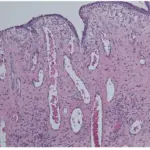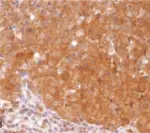Sinonasal (Schneiderian) papilloma is a benign infiltrative epithelial neoplasm arising from ectodermal derived pseudostratified ciliated epithelium which covers the nasal cavity and sinonasal tract.
What is the Pathology of Sinonasal (Schneiderian) Papilloma?
The pathology of sinonasal (Schneiderian) papilloma is:
-Etiology: The cause of sinonasal (Schneiderian) papilloma is unknown.
-Genes involved: None.
-Pathogenesis: The sequence of events that lead to sinonasal (Schneiderian) papilloma is tumorous growth of cells.
-Histology: The histology associated with sinonasal (Schneiderian) papilloma shows fungiform type composed of thick squamous epithelium, less frequently, respiratory epithelium organized in papillary fronds with an exophytic type of growth. the study of finger-like epithelial proliferations benign neoplasms that originate in the sinonasal tract.
How does Sinonasal (Schneiderian) Papilloma Present?
Patients with sinonasal (Schneiderian) papilloma typically Men are affected 4 times more often than women, present at age range of 6-90 years old. The symptoms, features, and clinical findings associated with sinonasal (Schneiderian) papilloma include Unilateral polypoidal mass filling and nasal obstruction, nasal discharge, epistaxis, epiphora, and facial agony.
How is Sinonasal (Schneiderian) Papilloma Diagnosed?
Sinonasal (Schneiderian) papilloma is diagnosed through imaging study preoperative radiographic assessment, CT scanning, and MRI, laboratory work, biopsy.
How is Sinonasal (Schneiderian) Papilloma Treated?
Sinonasal (Schneiderian) papilloma is treated through medical therapy for sinusitis complications.
What is the Prognosis of Sinonasal (Schneiderian) Papilloma?
The prognosis of sinonasal (Schneiderian) papilloma is fair with proper management.



